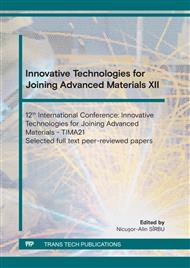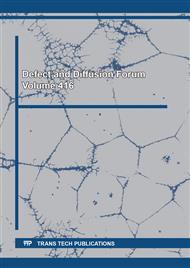p.3
p.11
p.21
p.31
p.43
p.55
p.67
p.79
p.87
Considerations Regarding Friction Stir Welding of Stainless Steels
Abstract:
Due to their extraordinary qualities, X5CrNi18-10 (AISI 304L) and X3CrNiMo17-13-3 (AISI 316) stainless steels are among the most used materials in engineering applications with use in priority areas. This also involves finding new solutions for joining this type of metals, effective alternatives to the widely used conventional welding processes.The paper presents the approaches and results obtained at international level for the FSW welding of X5CrNi18-10 and X3CrNiMo17-13-3 stainless steels.The ISIM results are also presented for the FSW butt welding of X5CrNi18-10 stainless steel plates, 4.0 mm and 1.5 mm thick. Data regarding the materials to be welded, the characteristics of the welding tool and the technological process parameters are presented: the rotation speed of the welding tool and the welding speed.When monitoring the welding process, a method was used that is based on an innovative solution based on the use of the infrared thermographic technique, patented by ISIM Timisoara.When welding FSW in inert gas environment FSW-IG, an innovative technical solution for applying the method was used (submitted for patenting), a method that allows monitoring the process in the case of FSW-IG as well. The results of the evaluation process of the welded joints are also presented: referring to metallographic analyzes at macro and microscopic level, micro-hardness, tensile and bending tests.The very good results obtained internationally, but also those obtained at ISIM Timisoara, represent solid arguments that the FSW process can be applied with very good results for welding of X5CrNi18-10 and X3CrNiMo17-13-3 stainless steels.
Info:
Periodical:
Pages:
31-41
Citation:
Online since:
May 2022
Keywords:
Price:
Сopyright:
© 2022 Trans Tech Publications Ltd. All Rights Reserved
Share:
Citation:



